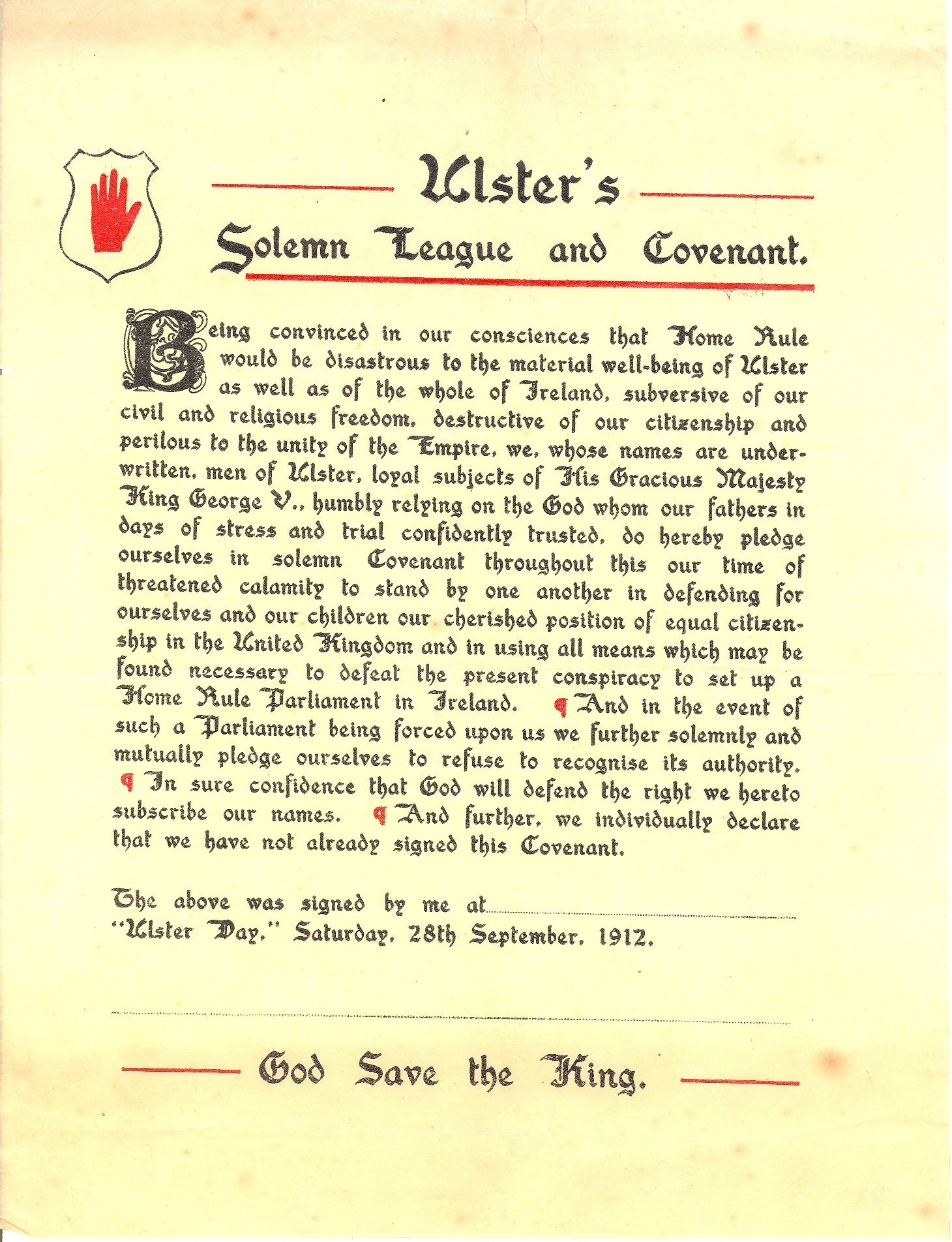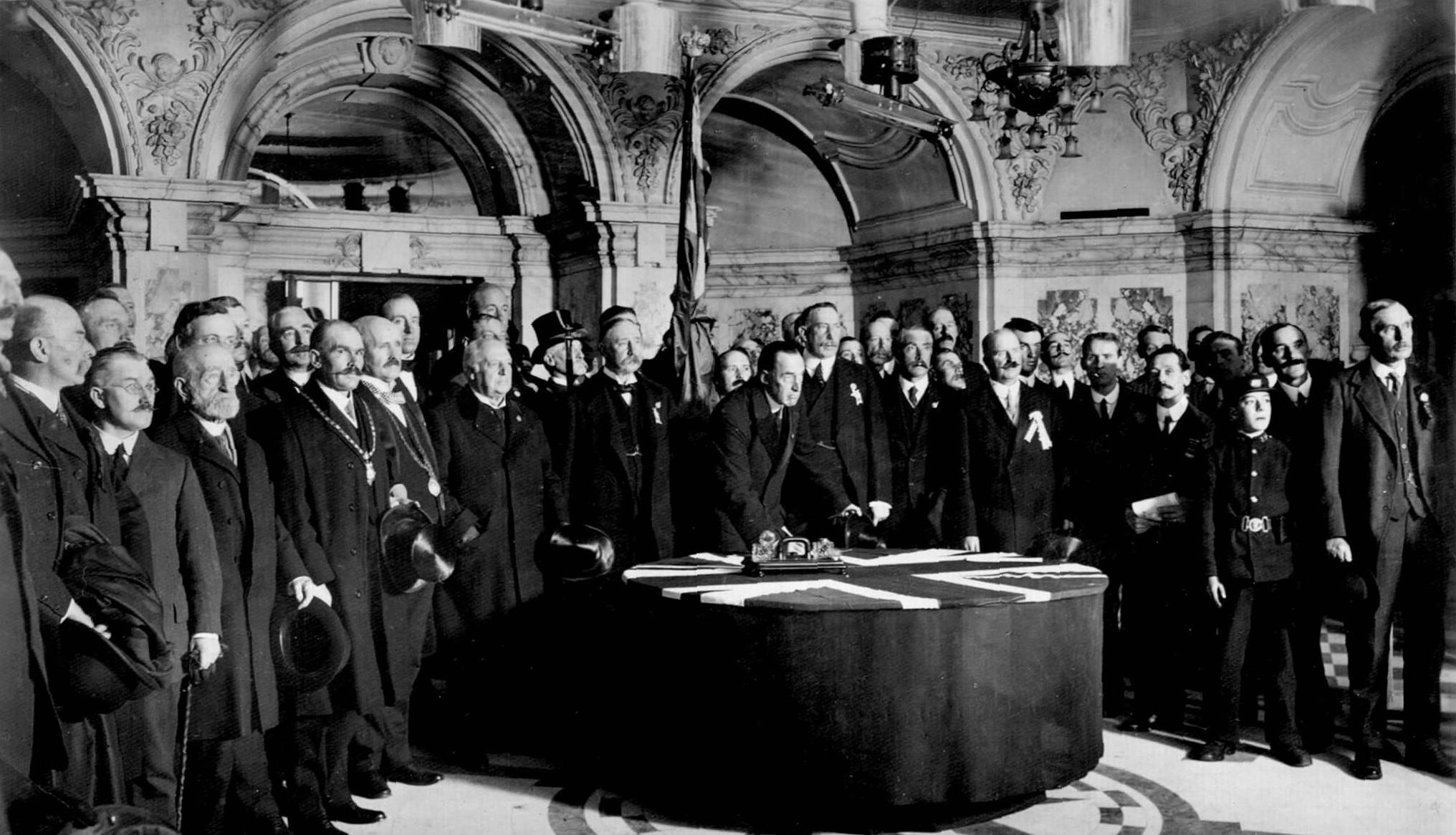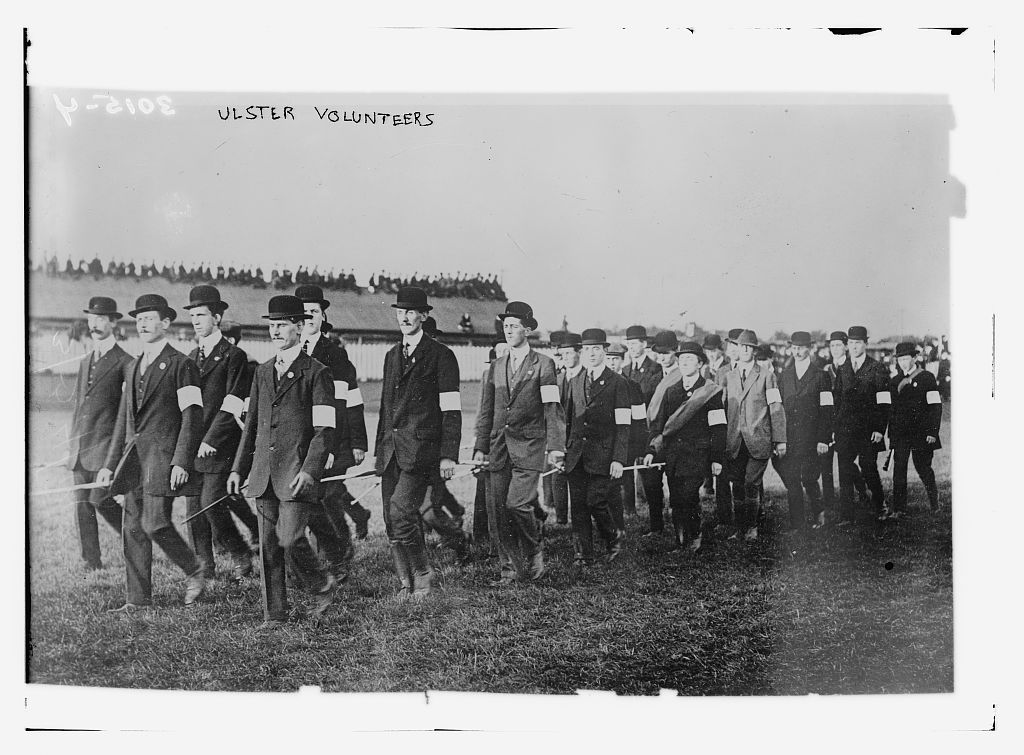|
Thomas Sinclair (politician, 1838–1914)
Thomas Sinclair (23 September 1838 – 14 February 1914), was an Ulster-Scots businessman and politician who drafted the Ulster Covenant. Early life and family Thomas Sinclair was born in Belfast on 23 September 1838. His parents were Thomas (1811–1867), merchant and shipowner, and Sarah Sinclair (1800–1849) (née Archer). Sinclair's father went into business with his brother John (1808–1856), setting up a provisions and general merchant store at 5–11, Tomb Street, Belfast. John married Eliza Pirrie, the relative of the prominent ship builder William Pirrie, 1st Viscount Pirrie. After the death of his father, Sinclair inherited £35,000 as his mother, brother and sister were all deceased. In 1876, Sinclair married Mary Duffin of Strandtown Lodge, Belfast. They had a daughter, Frances Elizabeth Crichton, and a son. She died in 1879. He married Elizabeth Richardson in 1882. She was the niece of John Grubb Richardson and the widow of Sinclair's cousin, John M. Sincl ... [...More Info...] [...Related Items...] OR: [Wikipedia] [Google] [Baidu] |
Ulster Covenant
Ulster's Solemn League and Covenant, commonly known as the Ulster Covenant, was signed by nearly 500,000 people on and before 28 September 1912, in protest against the Third Home Rule Bill introduced by the British Government in the same year. Signing The Covenant was first drafted by Thomas Sinclair, a prominent unionist and businessman from Belfast. Sir Edward Carson was the first person to sign the Covenant at Belfast City Hall with a silver pen, followed by The 6th Marquess of Londonderry (the former Lord Lieutenant of Ireland), representatives of the Protestant churches, and then by Sir James Craig. The signatories, 471,414 in all, PRONI �Historical Topics Series: 5/ref> were all against the establishment of a Home Rule parliament in Dublin. The Ulster Covenant is immortalised in Rudyard Kipling's poem " Ulster 1912". On 23 September 1912, the Ulster Unionist Council voted in favour of a resolution pledging itself to the Covenant. The Covenant had two basic parts: the ... [...More Info...] [...Related Items...] OR: [Wikipedia] [Google] [Baidu] |
Ulster Unionist Party
The Ulster Unionist Party (UUP) is a unionist political party in Northern Ireland. The party was founded in 1905, emerging from the Irish Unionist Alliance in Ulster. Under Edward Carson, it led unionist opposition to the Irish Home Rule movement. Following the partition of Ireland, it was the governing party of Northern Ireland between 1921 and 1972. It was supported by most unionist voters throughout the conflict known as the Troubles, during which time it was often referred to as the Official Unionist Party (OUP). Under David Trimble, the party helped negotiate the Good Friday Agreement of 1998, which ended the conflict. Trimble served as the first First Minister of Northern Ireland from 1998 to 2002. However, it was overtaken as the largest unionist party in 2003 by the Democratic Unionist Party (DUP). As of 2022 it is the fourth-largest party in the Northern Ireland Assembly, after the DUP, Sinn Féin, and the Alliance Party. The party has been unrepresented in Westmins ... [...More Info...] [...Related Items...] OR: [Wikipedia] [Google] [Baidu] |
Irish Unionists
Unionism is a political tradition on the island of Ireland that favours political union with Great Britain and professes loyalty to the United Kingdom, British Monarchy of the United Kingdom, Crown and Constitution of the United Kingdom, constitution. As the overwhelming sentiment of Ireland's Protestantism in Ireland, Protestant minority, following Catholic Emancipation (1829) unionism mobilised to keep Ireland part of the United Kingdom of Great Britain and Ireland, United Kingdom and to defeat the efforts of Irish nationalism, Irish nationalists to restore a separate Parliament of Ireland, Irish parliament. Since Partition of Ireland, Partition (1921), as Ulster Unionism its goal has been to maintain Northern Ireland as part of the United Kingdom and to resist a transfer of sovereignty to an United Ireland, all-Ireland republic. Within the framework of a Good Friday Agreement, 1998 peace settlement, unionists in Northern Ireland have had to accommodate Irish nationalists in ... [...More Info...] [...Related Items...] OR: [Wikipedia] [Google] [Baidu] |
Politicians From Belfast
A politician is a person active in party politics, or a person holding or seeking an elected office in government. Politicians propose, support, reject and create laws that govern the land and by an extension of its people. Broadly speaking, a politician can be anyone who seeks to achieve political power in a government. Identity Politicians are people who are politically active, especially in party politics. Political positions range from local governments to state governments to federal governments to international governments. All ''government leaders'' are considered politicians. Media and rhetoric Politicians are known for their rhetoric, as in speeches or campaign advertisements. They are especially known for using common themes that allow them to develop their political positions in terms familiar to the voters. Politicians of necessity become expert users of the media. Politicians in the 19th century made heavy use of newspapers, magazines, and pamphlets, as well ... [...More Info...] [...Related Items...] OR: [Wikipedia] [Google] [Baidu] |
1914 Deaths
This year saw the beginning of what became known as World War I, after Archduke Franz Ferdinand of Austria, heir to the Austrian throne was Assassination of Archduke Franz Ferdinand, assassinated by Serbian nationalist Gavrilo Princip. It also saw the first airline to provide scheduled regular commercial passenger services with heavier-than-air aircraft, with the St. Petersburg–Tampa Airboat Line. Events January * January 1 – The St. Petersburg–Tampa Airboat Line in the United States starts services between St. Petersburg, Florida, St. Petersburg and Tampa, Florida, becoming the first airline to provide scheduled regular commercial passenger services with heavier-than-air aircraft, with Tony Jannus (the first federally-licensed pilot) conveying passengers in a Benoist XIV flying boat. Abram C. Pheil, mayor of St. Petersburg, is the first airline passenger, and over 3,000 people witness the first departure. * January 11 – The Sakurajima volcano in Japan b ... [...More Info...] [...Related Items...] OR: [Wikipedia] [Google] [Baidu] |
1838 Births
Events January–March * January 10 – A fire destroys Lloyd's Coffee House and the Royal Exchange in London. * January 11 – At Morristown, New Jersey, Samuel Morse, Alfred Vail and Leonard Gale give the first public demonstration of Morse's new invention, the telegraph. * January 11 - A 7.5 earthquake strikes the Romanian district of Vrancea causing damage in Moldavia and Wallachia, killing 73 people. * January 21 – The first known report about the lowest temperature on Earth is made, indicating in Yakutsk. * February 6 – Boer explorer Piet Retief and 60 of his men are massacred by King Dingane kaSenzangakhona of the Zulu people, after Retief accepts an invitation to celebrate the signing of a treaty, and his men willingly disarm as a show of good faith. * February 17 – Weenen massacre: Zulu impis massacre about 532 Voortrekkers, Khoikhoi and Basuto around the site of Weenen in South Africa. * February 24 – U.S. Representatives William J. Graves of K ... [...More Info...] [...Related Items...] OR: [Wikipedia] [Google] [Baidu] |
Thomas Sinclair (politician, 1857–1940)
Thomas Sinclair, (17 December 1857 – 25 November 1940) was an Irish unionist politician. Sinclair studied at Queen's University, Belfast before working as a surgeon. He was elected to the Senate of Northern Ireland on its creation in 1921.The Northern Ireland Senate, 1921-72 Northern Ireland Elections He was elected as an Ulster Unionist Party Member of Parliament (MP) for |
Royal Victoria Hospital, Belfast
The Royal Victoria Hospital commonly known as "the Royal", the "RVH" or "the Royal Belfast", is a hospital in Belfast, Northern Ireland. It is managed by the Belfast Health and Social Care Trust. The hospital has a Regional Virus Centre, which is one of the four laboratories in the United Kingdom on the WHO list of laboratories able to perform PCR for rapid diagnosis of influenza A (H1N1) virus infection in humans. History Early history The Royal Victoria Hospital has its origins in a number of successive institutions, beginning in 1797 with The Belfast Fever Hospital and General Dispensary, located in Factory Row (although the dispensary originally opened in 1792). This moved to West Street in 1799, and then to Frederick Street in 1817. In 1847 the hospital separated from the General Dispensary and became the Belfast General Hospital. In 1875 it gained the royal charter, becoming the Belfast Royal Hospital, and in 1899 it was renamed the Royal Victoria Hospital. In 1903 it ... [...More Info...] [...Related Items...] OR: [Wikipedia] [Google] [Baidu] |
Henrietta Rae
Henrietta Emma Ratcliffe Rae (30 December 1859 – 26 January 1928) was a British painter of the late Victorian era,Arthur Fish''Henrietta Rae (Mrs. Ernest Normand)'' London, Cassell & Co., 1905. who specialised in classical, allegorical and literary subjects. Her best-known painting is '' The Lady with the Lamp'' (1891); depicting Florence Nightingale at Scutari. Biography Henrietta Rae was born on 30 December 1859 in Hammersmith, London, to Thomas Burbey Rae, a civil servant, and Ann Eliza Rae (), a musician who had been a student of Felix Mendelssohn. She had three brothers and three sisters. Rae began formally studying art at the age of thirteen, being educated at the Queen Square School of Art, Heatherley's School of Art (as the school's first female pupil) and at the British Museum. Rae reportedly applied to the Royal Academy of Arts at least five times before eventually gaining a seven-year scholarship. Her teachers there included Sir Lawrence Alma-Tadema, who had the str ... [...More Info...] [...Related Items...] OR: [Wikipedia] [Google] [Baidu] |
Frank McKelvey
Frank McKelvey (3 June 1895 – 30 June 1974) was an Irish painter from Belfast. Early life and education Francis Baird McKelvey, also known as Frank McKelvey, was born 3 June 1895. He was born in Belfast at 31 Woodvale Road. He was baptised at Saint Matthew's Parish Church. His parents William and Mary McKelvey had six children, three sons and three daughters. McKelevy was the second oldest. William, his father, was a decorator and painter. McKelvey attended Mayo Street National School in Belfast. When he was 16 he became a lithographer apprentice to the firm, David Allen & Sons. They produced postcards, posters and notices. McKelvey enrolled in the Belfast College of Art part time by attending evening classes until he left his employment in 1911 to study full-time. Alfred Rawlings Baker, McKelvey's art master, had great influence on him during his time at art college. McKelvey received numerous awards for his artworks including the Sir Charles Brett Sir Charles ... [...More Info...] [...Related Items...] OR: [Wikipedia] [Google] [Baidu] |
Ulster Museum
The Ulster Museum, located in the Botanic Gardens in Belfast, has around 8,000 square metres (90,000 sq. ft.) of public display space, featuring material from the collections of fine art and applied art, archaeology, ethnography, treasures from the Spanish Armada, local history, numismatics, industrial archaeology, botany, zoology and geology. It is the largest museum in Northern Ireland, and one of the components of National Museums Northern Ireland. History The Ulster Museum was founded as the Belfast Natural History Society in 1821 and began exhibiting in 1833. It has included an art gallery since 1890. Originally called the Belfast Municipal Museum and Art Gallery, in 1929, it moved to its present location in Stranmillis. The new building was designed by James Cumming Wynne. In 1962, courtesy of the Museum Act (Northern Ireland) 1961, it was renamed as the Ulster Museum and was formally recognised as a national museum. A major extension constructed by McLaughlin ... [...More Info...] [...Related Items...] OR: [Wikipedia] [Google] [Baidu] |
Ulster Volunteers
The Ulster Volunteers was an Irish unionist, loyalist paramilitary organisation founded in 1912 to block domestic self-government ("Home Rule") for Ireland, which was then part of the United Kingdom. The Ulster Volunteers were based in the northern province of Ulster. Many Ulster Protestants and Irish unionists feared being governed by a nationalist Catholic-majority parliament in Dublin and losing their links with Great Britain. In 1913, the militias were organised into the Ulster Volunteer Force (UVF) and vowed to resist any attempts by the British Government to impose Home Rule on Ulster. Later that year, Irish nationalists formed a rival militia, the Irish Volunteers, to safeguard Home Rule. In April 1914, the UVF smuggled 25,000 rifles into Ulster from Imperial Germany. The Home Rule Crisis was interrupted by the First World War. Much of the UVF enlisted with the British Army's 36th (Ulster) Division and went to fight on the Western Front. After the war, the British ... [...More Info...] [...Related Items...] OR: [Wikipedia] [Google] [Baidu] |






.png)
